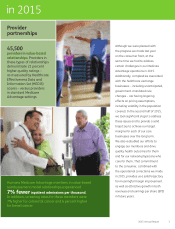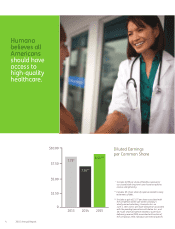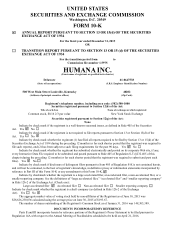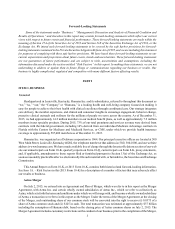Humana 2015 Annual Report Download - page 15
Download and view the complete annual report
Please find page 15 of the 2015 Humana annual report below. You can navigate through the pages in the report by either clicking on the pages listed below, or by using the keyword search tool below to find specific information within the annual report.7
CMS uses monthly rates per person for each county to determine the fixed monthly payments per member to pay
to health benefit plans. These rates are adjusted under CMS’s risk-adjustment model which uses health status indicators,
or risk scores, to improve the accuracy of payment. The risk-adjustment model, which CMS implemented pursuant to
the Balanced Budget Act of 1997 (BBA) and the Benefits and Improvement Protection Act of 2000 (BIPA), generally
pays more for members with predictably higher costs and uses principal hospital inpatient diagnoses as well as diagnosis
data from ambulatory treatment settings (hospital outpatient department and physician visits) to establish the risk-
adjustment payments. Under the risk-adjustment methodology, all health benefit organizations must collect from
providers and submit the necessary diagnosis code information to CMS within prescribed deadlines.
At December 31, 2015, we provided health insurance coverage under CMS contracts to approximately 2,753,400
individual Medicare Advantage members, including approximately 587,400 members in Florida. These Florida
contracts accounted for premiums revenue of approximately $7.8 billion, which represented approximately 26.3% of
our individual Medicare Advantage premiums revenue, or 14.5% of our consolidated premiums and services revenue
for the year ended December 31, 2015.
Our HMO, PPO, and PFFS products covered under Medicare Advantage contracts with CMS are renewed generally
for a calendar year term unless CMS notifies us of its decision not to renew by May 1 of the calendar year in which
the contract would end, or we notify CMS of our decision not to renew by the first Monday in June of the calendar
year in which the contract would end. All material contracts between Humana and CMS relating to our Medicare
Advantage products have been renewed for 2016, and all of our product offerings filed with CMS for 2016 have been
approved.
Individual Medicare Stand-Alone Prescription Drug Products
We offer stand-alone prescription drug plans, or PDPs, under Medicare Part D, including a PDP offering co-branded
with Wal-Mart Stores, Inc., or the Humana-Walmart plan. Generally, Medicare-eligible individuals enroll in one of our
plan choices between October 15 and December 7 for coverage that begins on the following January 1. Our stand-alone
PDP offerings consist of plans offering basic coverage with benefits mandated by Congress, as well as plans providing
enhanced coverage with varying degrees of out-of-pocket costs for premiums, deductibles, and co-insurance. Our
revenues from CMS and the beneficiary are determined from our PDP bids submitted annually to CMS. These revenues
also reflect the health status of the beneficiary and risk sharing provisions as more fully described in Item 7. –
Management’s Discussion and Analysis of Financial Condition and Results of Operations under the section titled
“Medicare Part D Provisions.” Our stand-alone PDP contracts with CMS are renewed generally for a calendar year
term unless CMS notifies us of its decision not to renew by May 1 of the calendar year in which the contract would
end, or we notify CMS of our decision not to renew by the first Monday in June of the calendar year in which the
contract would end. All material contracts between Humana and CMS relating to our Medicare stand-alone PDP products
have been renewed for 2016, and all of our product offerings filed with CMS for 2016 have been approved.
We have administered CMS’s Limited Income Newly Eligible Transition, or LI-NET, prescription drug plan
program since 2010. This program allows individuals who receive Medicare’s low-income subsidy to also receive
immediate prescription drug coverage at the point of sale if they are not already enrolled in a Medicare Part D plan.
CMS temporarily enrolls newly identified individuals with both Medicare and Medicaid into the LI-NET prescription
drug plan program, and subsequently transitions each member into a Medicare Part D plan that may or may not be a
Humana Medicare plan.
Group Medicare Advantage and Medicare stand-alone PDP
We offer products that enable employers that provide post-retirement health care benefits to replace Medicare wrap
or Medicare supplement products with Medicare Advantage or stand-alone PDPs from Humana. These products offer
the same types of benefits and services available to members in our individual Medicare plans discussed previously
and can be tailored to closely match an employer’s post-retirement benefit structure.
























